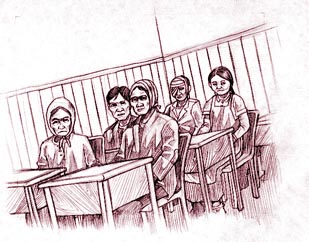In many institutions there were informal systems of intimidation and protection in which food figured prominently. A student who wanted protection from bullies could sometimes purchase it by promising to give up a treat from home, or by pledging an item of food for a set number of days to the protector. 'Pumpkin Head,' a student at the Anglican Blood school, got 'a whole pile of toast' every morning as payment 'for protecting those junior boys who didn't have older brothers to protect them.'
Among the material aspects of residential school life, clothing ran a close second to food for the title of most detested. With clothing as with food, students' negative reactions were often made worse by the insensitivity with which they were treated by the staff responsible for overseeing clothing supplies. Particularly resented where instances where students were humiliated if they soiled clothing or bed linens.
Inadequate clothing and substandard food undoubtedly contributed to the poor health that prevailed in the residential schools throughout their long existence. Tuberculosis remained the principal scourge of residential schools, as it did of western Indian reserves in particular, throughout the first half of the twentieth century.

Sarcee Anglican school classroom containing healthy children and those suffering from active tuberculosis sores
In the prairies in particular in the interwar years a ferocious battle was fought against tuberculosis, both in the schools and on the reserves at large. The most strenuous example occurred on the Sarcee reserve near Calgary, which, like most of the southern Alberta schools and reserves, was a hotbed of tuberculosis. Examination of the Sarcee boarding school in the autumn of 1920 revealed that only four of the institution's thirty-three students did not have some tuberculosis, and that sixteen had 'suppurating glands or open ulcers and many sit at their desks with unsightly bandages around their necks to cover up their large swellings and foul sores.' That year three students died, and in 1921 health conditions among the student body deteriorated still further. The result of the dreadful conditions was that the Indian Affairs department took over the Sarcee school and operated it as a tuberculosis sanatorium through the 1920s and into the 1930s. At Sarcee, as in many of the prairie institutions, improvement came only gradually, as living conditions slowly improved.


